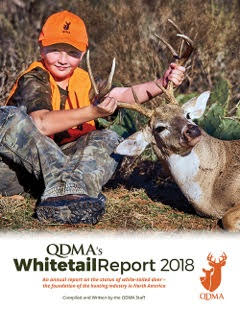Michigan State University and the Michigan Department of Natural Resources will be placing location-tracking collars on white-tailed deer in south-central Michigan as part of a multiyear study of deer disease, including chronic wasting disease.
The study will assess deer movement and distribution patterns, and their influence on disease spread in and around Clinton and Ingham counties. This is one of a series of aggressive actions to address CWD in Michigan’s deer population and to maintain healthy wildlife for current and future generations.
Chronic wasting disease attacks the brain of infected animals, creating small lesions, which result in death. The disease is transmitted through direct animal-to-animal contact or by contact with saliva, urine, feces, blood or body parts of an infected animal, or infected soil. CWD first was detected in free-ranging deer in mid-Michigan in 2015.
The disease can spread through the deer herd and, once established, could – over the long term – significantly reduce the number of deer in the region and/or depress numbers of older age-class deer.
Presently, there are no known health risks posed to humans by CWD. As a precaution, however, the U.S. Centers for Disease Control and Prevention recommends animals infected with the disease not be eaten.
A scientifically based understanding of localized deer dispersal rates, timing and direction, seasonal movement patterns and basic population characteristics is critical for developing effective disease control strategies.
“We know that that CWD may be spread through direct deer-to-deer contact and by the shedding of CWD proteins, or ‘prions,’ into the environment. By understanding where and why deer are moving across the region, we can better understand the role deer play in moving the disease,” said Dr. Sonja Christensen, postdoctoral research fellow in the Boone and Crockett Quantitative Wildlife Center at MSU.
This study will improve the ability to proactively manage CWD, particularly in areas where the disease is just being discovered.
“Understanding how local deer populations change with the presence of CWD and associated management actions will help us measure the effectiveness of disease control actions and anticipate future disease management needs,” said Dr. Dwayne Etter, DNR research specialist.
Another benefit of this research is the ability to measure how deer move during different seasons and to track movement in real time. Importantly, it could help the DNR and partners focus efforts on areas with high probabilities of disease risk.
This work is part of a larger collaborative effort between the DNR, MSU, the Hal and Jean Glassen Memorial Foundation and the Boone and Crockett Club, aimed at improving wildlife disease surveillance and management statewide.
“CWD is a serious threat to the state’s deer population and conservation efforts. No single stakeholder group has any hope of tackling that challenge alone. The Boone and Crockett Quantitative Wildlife Center and our Michigan Deer Disease Initiative are uniquely positioned to partner with hunters, wildlife watchers, natural resource managers, veterinarians and scientists across the country to tackle the challenge of CWD in Michigan so that our kids and grandkids can see and hunt healthy deer,” said Dr. David Williams, principal investigator of the study and assistant professor at MSU.
For more information on deer in Michigan, visit www.mi.gov/deer; for more on chronic wasting disease, visit www.mi.gov/cwd. Information about the deer movement study can be found at www.bcqwc.org/cwd.html.







